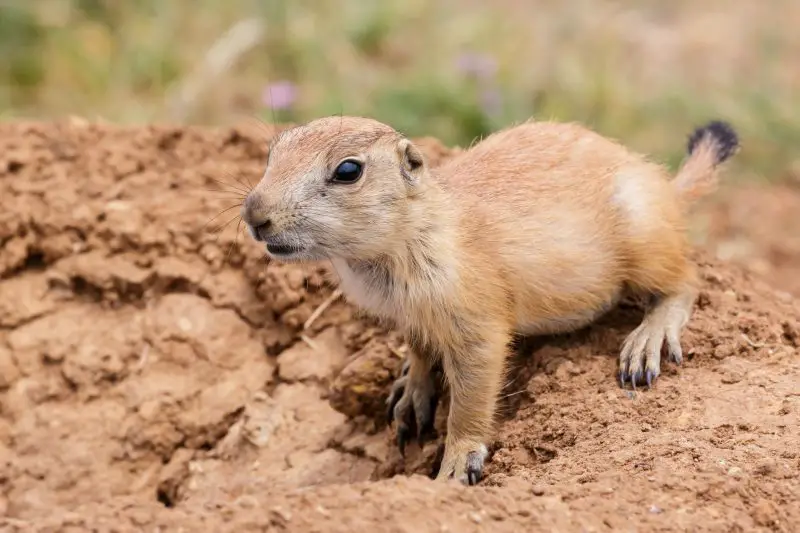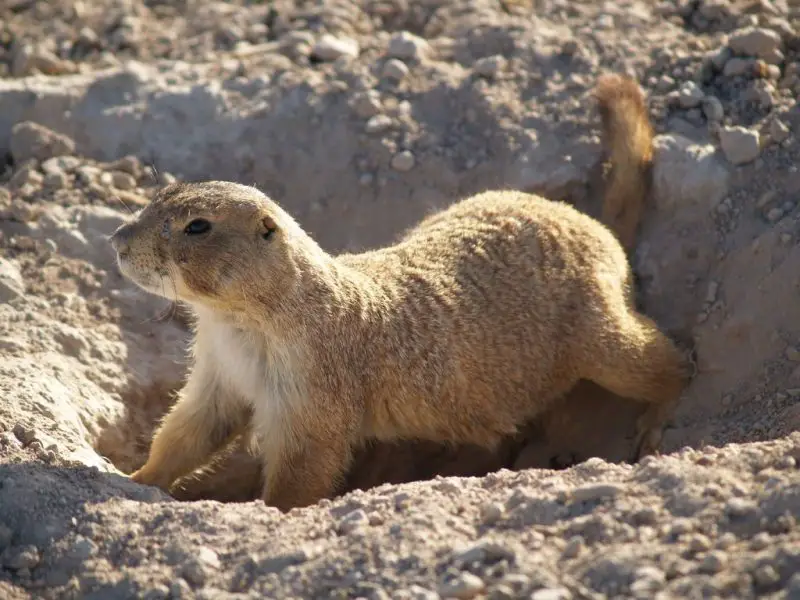In the vast landscapes of Texas, prairie dogs are some of the most intriguing creatures to observe. These small, burrowing rodents are often recognized by their sociable nature, intricate colonies, and unique vocalizations. Known for their complex underground tunnel systems and community living, prairie dogs play a vital role in maintaining the grassland ecosystem. In Texas, two species of prairie dogs can be observed, each with distinct characteristics, behaviors, and ecological roles.
Exploring these prairie dogs in their natural habitats provides insight into the delicate balance of Texas grasslands. Their intricate social behaviors, foraging patterns, and breeding strategies reveal a species that is both resourceful and critical to its environment. Understanding the differences between the species can help wildlife enthusiasts, researchers, and conservationists identify, appreciate, and protect these captivating creatures.
Black-tailed Prairie Dog (Cynomys ludovicianus)

Identification and Physical Characteristics
The black-tailed prairie dog is the more widely recognized species in Texas, primarily inhabiting the Panhandle and northern grasslands. Adults typically measure between 12 and 16 inches in length, not including their 3- to 4-inch black-tipped tails. Their fur is a mixture of tan and brown tones, blending seamlessly with the prairie environment, while their tail provides a contrasting dark marker that is essential for identification.
Their heads are rounded, with small, alert ears and large, expressive eyes adapted to detect predators. Black-tailed prairie dogs have strong, clawed forelimbs that facilitate digging and creating extensive burrow systems. These burrows, often complex networks of tunnels and chambers, serve as protection against predators and extreme weather conditions.
Behavior and Social Structure
Black-tailed prairie dogs are highly social animals, living in colonies called “towns” that can span hundreds of acres. Within these towns, smaller family units known as coteries are established, consisting of a dominant male, several females, and their offspring. Social behaviors include grooming, playing, and intricate vocal communications, which are used to alert the colony of approaching threats.
These prairie dogs are diurnal, being most active during the early morning and late afternoon. They spend a significant portion of their day foraging, grooming, and maintaining their burrows. Their vocalizations are diverse, with distinct alarm calls for different predators, making their communication system one of the most sophisticated among rodents.
Feeding and Diet
Black-tailed prairie dogs are primarily herbivorous, feeding on grasses, roots, seeds, and various forbs. Their foraging behavior is highly selective, ensuring they obtain sufficient nutrients from the available vegetation. Occasionally, they may consume insects, although this represents a minor part of their diet.
Foraging is usually conducted near the entrance of their burrows, allowing them to quickly retreat if danger approaches. This proximity to their tunnels ensures both safety and a constant supply of fresh food, which contributes to their survival in the open grasslands of Texas.
Reproduction and Life Cycle
Reproduction in black-tailed prairie dogs begins in early spring. After a gestation period of approximately 34 to 37 days, females give birth to litters ranging from three to eight pups. The young are born blind and hairless, relying entirely on their mothers for the first several weeks of life.
As they grow, juveniles start emerging from the burrow to explore and interact with other colony members, gradually learning the social and foraging behaviors necessary for survival. Sexual maturity is typically reached at one year of age, and females can reproduce annually, contributing to the growth and maintenance of the colony population.
Habitat and Distribution in Texas
In Texas, black-tailed prairie dogs predominantly occupy the High Plains region, favoring shortgrass prairies and open fields. They prefer areas with well-drained soil suitable for burrowing and adequate vegetation for foraging. Their presence significantly influences the local ecosystem, providing habitats for other species such as burrowing owls, snakes, and foxes.
Urban expansion and agricultural development have reduced their natural habitats in some areas. However, conservation efforts are underway to preserve prairie dog towns and maintain the biodiversity of Texas grasslands.
Fun Facts
Black-tailed prairie dogs are known for their elaborate “dancing” displays, where individuals stand upright, jump, and make vocalizations to communicate excitement or warn of potential danger. These social interactions are not only functional but also strengthen the bonds within the colony.
Interestingly, their burrowing activities help aerate the soil and enhance nutrient cycling, making them ecological engineers of the prairie ecosystem. Observing a prairie dog town in Texas is like watching a bustling underground city come alive, showcasing one of nature’s most organized rodent societies.
Mexican Prairie Dog (Cynomys mexicanus)

Identification and Physical Characteristics
The Mexican prairie dog is less common in Texas, primarily found in the southwestern regions near the Mexican border. They are slightly smaller than their black-tailed cousins, with adults typically ranging from 10 to 14 inches in length, accompanied by a tail measuring 2 to 3 inches. Their fur is lighter, often a sandy or yellowish-brown color, allowing for excellent camouflage in the arid landscapes they inhabit.
Distinctive features include a shorter, less pronounced tail and smaller ear size. Their compact bodies and sturdy limbs are perfectly adapted for digging extensive burrow systems in dry, hard soils. These physical traits support their survival in harsher environments where water is scarce, and vegetation is sparse.
Behavior and Social Structure
Like black-tailed prairie dogs, Mexican prairie dogs are social and form colonies. However, their colonies tend to be smaller, and social structures are slightly less complex. Family units still exist, but interactions are more subdued compared to the highly active black-tailed prairie dogs.
Mexican prairie dogs are vigilant and cautious, spending more time surveying their surroundings before venturing into open areas. They communicate using a range of chirps and whistles, although their calls are often quieter and less frequent than those of the black-tailed species.
Feeding and Diet
Mexican prairie dogs primarily feed on grasses and shrubs, relying on whatever vegetation is available in the semi-arid grasslands. Their diet occasionally includes seeds and small roots, which provide essential nutrients and water in dry conditions.
Foraging is carefully timed to avoid the hottest part of the day, reflecting their adaptation to a warmer, more arid climate. Their feeding habits help maintain the balance of local plant communities, preventing overgrowth and promoting biodiversity in their habitats.
Reproduction and Life Cycle
Reproduction for Mexican prairie dogs occurs similarly to black-tailed prairie dogs but often starts slightly earlier due to the warmer climate of southwestern Texas. Gestation lasts approximately 30 to 35 days, resulting in litters of three to six pups. Juveniles remain in the burrow for several weeks, gradually developing the skills needed to forage and communicate effectively with the colony.
Their reproductive strategies are adapted to the challenging environment, with timing and litter size ensuring the survival of young even in less favorable conditions. Mexican prairie dogs typically reach sexual maturity around one year of age, allowing colonies to maintain their populations steadily.
Habitat and Distribution in Texas
In Texas, Mexican prairie dogs occupy semi-arid grasslands, scrublands, and desert edge environments near the southern border. They prefer loose, well-drained soils for burrowing and areas where vegetation is sparse but sufficient for sustenance. Their presence indicates healthy grassland ecosystems and contributes to soil aeration and nutrient cycling.
Unlike black-tailed prairie dogs, Mexican prairie dogs are more sensitive to habitat disturbance and are often limited to protected or less developed areas. Their distribution is therefore more restricted, making conservation efforts particularly important.
Fun Facts
Mexican prairie dogs have a unique form of communication that allows them to alert each other to predators with subtle whistles that vary depending on the type of threat. Their quieter, more cautious demeanor is a fascinating adaptation to living in arid, open environments.
Additionally, these prairie dogs are known to dig exceptionally deep burrows, sometimes exceeding six feet in depth. This not only provides refuge from predators but also stabilizes the soil and contributes to the health of their grassland habitats.
Ecological Importance of Prairie Dogs in Texas
Prairie dogs are keystone species in Texas, meaning their presence and activities have a profound impact on the ecosystem. Their burrows provide shelter for a variety of other wildlife, including snakes, burrowing owls, and small mammals. The aeration and soil turnover from their digging improve plant growth and nutrient cycling, supporting a diverse range of flora and fauna.
Their grazing activities influence plant composition, preventing certain species from dominating and maintaining grassland biodiversity. As prey for hawks, coyotes, and foxes, prairie dogs also play a crucial role in the food web, supporting predator populations across Texas.
Conservation Status and Challenges
While prairie dogs are iconic residents of Texas grasslands, both species face challenges from habitat loss, disease, and human conflict. Agricultural development, urban expansion, and poisoning campaigns have historically reduced their numbers. Diseases such as sylvatic plague can also decimate colonies rapidly.
Conservation initiatives are focusing on habitat protection, disease monitoring, and public education to promote coexistence. Maintaining healthy prairie dog populations is essential not only for the species itself but also for the broader grassland ecosystem that depends on their ecological contributions.
Observing Prairie Dogs in Texas
For wildlife enthusiasts, observing prairie dogs in Texas offers a glimpse into a highly social and industrious species. Visits to protected prairie reserves or state parks provide opportunities to see black-tailed and Mexican prairie dogs in their natural habitats. Watching their behaviors—vigilant standing, playful chasing, and coordinated alarm calls—offers insight into one of the most organized rodent communities in North America.
Photographers and naturalists are particularly drawn to prairie dog towns, where the interplay of social behaviors and landscape creates striking visuals. Identifying the species is made easier by observing physical traits, tail coloration, and behavioral patterns.
Fun Facts Recap
Prairie dogs are more than just cute, burrowing rodents. They are engineers of the ecosystem, sophisticated communicators, and key contributors to the health of Texas grasslands. Their alarm calls, social dances, and burrowing activities not only support their survival but also enhance the biodiversity of their surroundings.
Whether it’s the black-tipped tail of the black-tailed prairie dog or the cautious, desert-adapted Mexican prairie dog, each species brings unique traits that fascinate observers and researchers alike. Their presence serves as a reminder of the complex and interconnected nature of prairie ecosystems in Texas.
Conclusion
Understanding the two types of prairie dogs in Texas provides valuable insight into the grassland ecosystems that define much of the state’s natural landscape. From the expansive, bustling towns of black-tailed prairie dogs to the more reserved, desert-adapted Mexican prairie dogs, these species demonstrate resilience, social complexity, and ecological importance.
Preserving their habitats and promoting awareness of their ecological roles is essential for maintaining the biodiversity of Texas grasslands. By appreciating these small yet significant creatures, we gain a deeper understanding of the intricate balance of nature and the vital role that every species plays in sustaining it.
Frequently Asked Questions About Prairie Dogs in Texas
What are the main types of prairie dogs found in Texas?
Texas is home to two species of prairie dogs: the Black-tailed Prairie Dog (Cynomys ludovicianus) and the Mexican Prairie Dog (Cynomys mexicanus). Each species has distinct physical features, behaviors, and habitat preferences, with black-tailed prairie dogs being more widespread and social, while Mexican prairie dogs are smaller and adapted to arid environments near the southern border.
How can I identify a black-tailed prairie dog?
Black-tailed prairie dogs are recognizable by their black-tipped tails, tan-brown fur, rounded heads, and large, expressive eyes. They are generally larger than Mexican prairie dogs, measuring 12 to 16 inches long, and are often seen standing upright at the entrance of their burrows to survey their surroundings.
How can I identify a Mexican prairie dog?
Mexican prairie dogs are slightly smaller, usually 10 to 14 inches long, with lighter sandy or yellowish-brown fur. Their tails are shorter and less prominent, and they are more cautious in behavior. This species is primarily found in southwestern Texas and prefers semi-arid grasslands and scrublands.
What do prairie dogs eat in Texas?
Prairie dogs are mostly herbivores. Their diet consists of grasses, roots, seeds, and forbs. Occasionally, they may consume insects, but vegetation forms the majority of their diet. They forage near their burrow entrances for safety and access to fresh food.
How do prairie dogs reproduce?
Female prairie dogs give birth once a year after a gestation period of about 30–37 days, depending on the species. Litters typically contain 3 to 8 pups. The young are born blind and hairless, spending the first weeks of life inside the safety of the burrow until they are ready to explore and interact with the colony.
Where do prairie dogs live in Texas?
Black-tailed prairie dogs are commonly found in the High Plains and northern prairies, while Mexican prairie dogs inhabit southwestern grasslands near the border with Mexico. Both species prefer open areas with well-drained soil suitable for digging burrows and sufficient vegetation for foraging.
How do prairie dogs communicate?
Prairie dogs have a complex vocal communication system, using chirps, whistles, and barks to alert colony members of predators. Alarm calls can vary depending on the type of threat, helping the colony respond appropriately. Black-tailed prairie dogs tend to be more vocal and interactive, whereas Mexican prairie dogs are quieter and more cautious.
Why are prairie dogs important for the ecosystem?
Prairie dogs are considered keystone species because their burrowing aerates the soil and promotes nutrient cycling. Their presence provides shelter for other animals, influences plant composition through grazing, and serves as a prey base for predators like hawks, coyotes, and foxes, thus supporting the balance of the Texas grassland ecosystem.
Are prairie dogs endangered in Texas?
While not officially endangered, prairie dog populations face threats from habitat loss, urban development, agriculture, and disease. Conservation efforts focus on protecting prairie dog towns, monitoring disease outbreaks, and promoting public awareness of their ecological importance.
Can I observe prairie dogs in the wild safely?
Yes, prairie dogs can be observed in protected prairie reserves, state parks, or natural grasslands. It’s best to keep a safe distance, avoid disturbing their burrows, and use binoculars or cameras to watch their social behaviors and interactions without causing stress.






